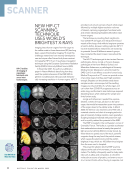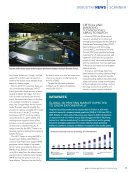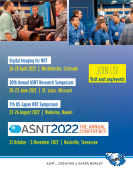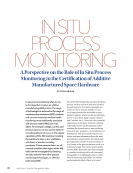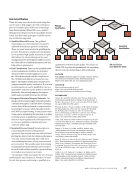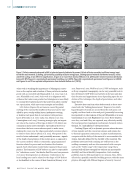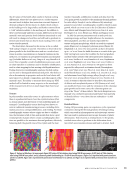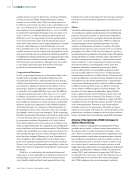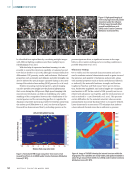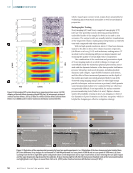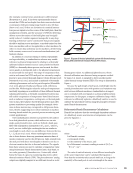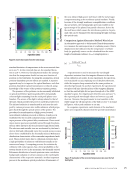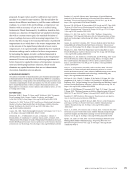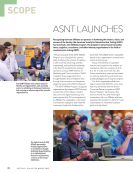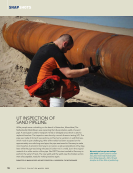from bone. Ackermann, Jonigk, and Lee wanted to use this huge instrument to perform the world’s most detailed X-ray scans of a human organ. But for all HiP-CT’s promise, there are also considerable challenges. HiP-CT scans generate a huge amount of data— several terabytes per organ. For clini- cians to make real-world use of these scans, the researchers hope to develop a cloud-based interface to navigate them, like Google Maps for the human body. They also need to simplify the process of creating workable 3D models from the scans. Like all CT scanning techniques, HiP-CT works by making many 2D slices of a given object and stacking them together. Much of this process is manual, especially for scans of abnormal or diseased tissues. A major priority for the HiP-CT team is to develop machine-learning techniques to lighten the load. The HiP-CT team is using the ESRF’s newest beam facility, called BM18, to continue scanning human organs. BM18 produces a much bigger X-ray beam, which means scans take less time, and BM18’s X-ray detector can be placed up to 38 m away from the object being scanned, which makes its scans sharper. BM18 also has the space to scan very large objects. Thanks to the new facility, the team’s vision is to scan an entire torso of a human body in one fell swoop by the end of 2023. To read the full paper published in Nature, go to nature.com/articles/ s41592-021-01317-x. CRITICAL AND EMERGING TECHNOLOGIES: AREAS TO WATCH In February 2022, the White House issued an updated list of critical and emerging technologies that the Office of Science and Technology Policy (OSTP), National Science and Technology Council (NSTC), and National Security Council (NSC) have identified as being important for US national security. Last updated in 2020, this list represents a subset of novel, advanced technologies with the potential to chart new pathways in American innovation and strengthen national security. Numerous technology areas have been featured, including advanced engi- neering materials, advanced manufac- turing (including additive manufacturing), advanced nuclear energy technologies, artificial intelligence (including machine learning), autonomous systems and robotics, human-machine interfaces INDUSTRYNEWS | SCANNER DATAFACTS | GLOBAL 3D PRINTING MARKET EXPECTED TO GROW EXPONENTIALLY The global 3D printing market size was valued at US$13.78 billion in 2020 and is expected to expand at a compound annual growth rate (CAGR) of 21.0% from 2021 to 2028. Globally, 2.1 million units of 3D printers were shipped in 2020, and shipments are expected to reach 15.3 million units by 2028. The aggressive R&D in 3D printing (referred to as “additive manufacturing” for industrial applications) and the growing demand for prototyping applications from various industry verticals—particularly healthcare, automotive, aerospace, and defense—are expected to drive market growth. Source: grandviewresearch.com Stereolithography Fused deposition modeling Selective Laser Sintering Direct metal laser sintering Polyjet printing Inkjet printing Electron beam melting Laser metal deposition Digital light processing Laminated object manufacturing Others 2017 1.85 2.21 2018 2019 2020 2021 2022 2023 2024 2025 2026 North America 3D printing market size, by technology, 2017–2028 (USD billion) 2027 2028 Top view of the circular tunnel at the European Synchrotron Radiation Facility in Grenoble, France. A P R I L 2 0 2 2 • M A T E R I A L S E V A L U A T I O N 9 CREATIVE COMMONS ATTRIBUTION-SHARE ALIKE 2.0 FRANCE LICENSE.
(including AR/VR), networked sensors and sensing, renewable energy gener- ation and storage, and space technol- ogies and systems. (For the full list, go to https://www.whitehouse.gov/ostp/ news-updates/2022/02/07/technolo gies-for-american-innovation-and-nation al-security/.) According to the White House, the list is intended as a useful resource that guides new and existing efforts to promote US technological leadership, cooperate with allies and partners, advance democratic values, attract and retain diverse science and technology talent from around the world, and protect against threats to US security. For example, on 21 January 2022, US Citizenship and Immigration Services, an agency in DHS, put in effect new policy guidance governing National Interest Waivers that utilizes the concept of critical and emerging technologies. The guid- ance stated that “USCIS recognizes the importance of progress in STEM fields and the essential role of persons with advanced STEM degrees in fostering this progress, especially in focused crit- ical and emerging technologies or other STEM areas important to US competitive- ness or national security.” PIRT TO DEVELOP HIGH-RES SWIR ELECTRO-OPTICAL SEEKER Princeton Infrared Technologies Inc. (PIRT), located in Monmouth Junction, New Jersey, and specialists in indium gallium arsenide (InGaAs) imaging tech- nology and affordable shortwave- infrared (SWIR) line scan cameras, visible-SWIR science cameras, and 1- and 2D imaging arrays, announced a Phase II Small Business Innovation Research (SBIR) award from the Office of the Secretary of Defense to fund the development of a megapixel high-reso- lution seeker with extended wavelength detection capability covering the entire SWIR range. The camera will have a high pixel operability with a digital output at greater than industry standard frame rate at full resolution. The imager will be manufac- tured on InP substrates using the InGaAs/ GaAsSb system allowing for low cost and the ability to utilize modern III-V semi- conductor processing. Additionally, the imager will be manufactured and hybrid- ized at wafer scale to minimize cost. IRISNDT ACQUIRES JAMES FISHER NDT IRISNDT announced the acquisition of James Fisher NDT from James Fisher and Sons PLC. James Fisher NDT has served the aerospace, defense, automo- tive, petrochemical, utilities, and nuclear markets since 2006, offering a wide array of field and laboratory NDT services. The component testing division of James Fisher NDT, providing quality control of manufactured parts, will continue to operate from its state-of-the-art 33 000 ft2 (3066 m2) facility, which includes eight radiographic bays, in Deeside, Wales, UK. IRISNDT is a privately owned NDT, inspection, and integrity engineering company with operations in the United States, Canada, the United Kingdom, and Australia. The company serves a blue-chip customer base in the refinery, petrochemical, chemical, agricultural, and power/renewables sectors around ongoing operational activities and main- tenance turnaround projects, as well as construction and expansion projects. The company is owned by IRISNDT employees and First Reserve, a private equity firm focused on energy and related industrial markets, and has 22 branch locations in the US, as well as nine in Canada, seven in the UK, and five in Australia. SCANNER | INDUSTRYNEWS We want to hear from you! News releases for Scanner should be submitted to Cara Markland, Assistant Editor, at cmarkland@asnt.org. www. .com • 2000 ASME & RFT tubes in stock - Same day shipping • Custom calibration standards • Mock-up exchangers / tube testing bundles • ('0QRWFKHVKROHVDQGÀDZV • S • Spiral notches & tube expansions • Corrosion simulation 10 M A T E R I A L S E V A L U A T I O N • A P R I L 2 0 2 2
ASNT grants non-exclusive, non-transferable license of this material to . All rights reserved. © ASNT 2025. To report unauthorized use, contact: customersupport@asnt.org











